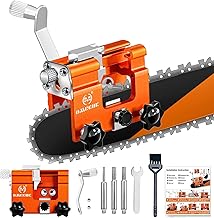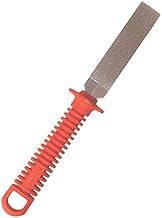When your saw blade gets dull, every cut becomes harder and less accurate. That’s why choosing the best saw sharpener is so important. But here’s the thing—finding the right one isn’t always easy.
Let’s face it: whether you’re cutting lumber, tackling DIY projects, or working in professional carpentry, sharp blades make all the difference. For example, if you’re researching the best saw to cut 2x4, you already know performance depends heavily on blade condition. The same goes for choosing the best saw set tool to maintain precision. Even among the best saws on the market, a dull blade reduces efficiency, safety, and accuracy.
So, how do you solve this problem? Simple—you invest in a sharpener that keeps your blades working like new. In this review, we’ll explore the best options, answer common questions, and help you pick the perfect sharpener for your needs.
Top Picks
Best Variable Speed: AVID POWER Electric Chainsaw Sharpener, 6 Variable Speeds Chain Saw Sharpening Kit
Equipped with a 1.2A motor and six adjustable speed settings, the AVID POWER electric chainsaw sharpener delivers stronger performance than manual alternatives. Its precision angle guides and three diamond sharpening bits ensure compatibility with most standard chains, while the ergonomic grip and lightweight build make extended use more comfortable. Customers highlight how quickly it restores dull blades and appreciate the versatility of using rotary tool attachments for other DIY tasks. Some note that beginners may need time to get used to the angle settings, but once mastered, the tool produces consistent and sharp results. Overall, this sharpener offers excellent efficiency and control at a reasonable price, making it a solid value for both casual users and professionals who want reliable chainsaw maintenance without relying on manual filing.
Best All-in-One Kit: Hipa 12 Pack Chainsaw File, Chainsaw Sharpener Kit
This Hipa 12-piece chainsaw file kit provides everything needed to sharpen chainsaws, pole saws, and similar tools with precision. The kit includes six round files in various sizes, a flat file, depth gauge tools, and a quick check gauge for angles and pitch measurements. With clearly marked file sizes and an ergonomic wooden handle, even beginners find it straightforward to use. The bright orange storage pouch enhances portability and visibility, making it ideal for fieldwork. Many customers value the convenience of having all essential tools in one kit, though some note that manual sharpening requires more time and physical effort compared to electric sharpeners. Overall, this kit stands out for its completeness, versatility, and affordability, offering a practical solution for users who prefer hands-on maintenance of their chainsaws.
Best Pocket Sharpener: Corona Sharpening Tool, Garden Tool Blade Sharpener, AC 8300
The Corona AC 8300 sharpening tool is a lightweight, portable option designed for quick blade touch-ups in the garden or workshop. Featuring a 5-inch super carbide file, it offers durability and effective sharpening for straight blades like pruners, loppers, and shears. Its small size makes it easy to carry in a pocket or tool bag, while the rubberized non-slip grip ensures safety and comfort during use. Customers appreciate its convenience and reliability for everyday maintenance, though it’s not suitable for saw blades or heavy-duty sharpening tasks. Overall, it’s a handy and affordable sharpener for keeping essential garden tools in working condition.
FAQs
Which is the best chainsaw sharpener?
The best chainsaw sharpener depends on your needs, budget, and level of experience. For professionals, electric sharpeners with adjustable angles provide speed and accuracy. These models often come with guides and clamps that ensure consistent sharpening. On the other hand, handheld file kits are affordable and portable, making them a solid choice for DIY users. Many woodworkers prefer bench-mounted sharpeners for heavy-duty tasks because they deliver precise results with minimal effort.
Do saw blade sharpeners work?
Yes, saw blade sharpeners work effectively when used correctly. They restore the cutting edge, improve blade performance, and extend the tool’s lifespan. Manual sharpeners require more skill but give you direct control, while electric sharpeners provide faster, consistent results. Using the right technique ensures you avoid removing too much material, which can shorten the blade’s life.
Is it worth sharpening my own chainsaw?
Sharpening your own chainsaw is absolutely worth it if you use the tool often. It saves time and money compared to taking the blade to a shop. Plus, it allows you to maintain performance on demand instead of waiting for professional service. With some practice, you can achieve professional-level sharpness at home. The key is to follow proper angles and avoid over-sharpening, which can reduce durability.
What are the best chainsaw sharpening techniques?
The best sharpening techniques involve maintaining the correct angle and ensuring even pressure on each tooth. For manual filing, use a round file matched to the chain size and follow the manufacturer’s angle guide. Make smooth, consistent strokes instead of aggressive filing. For electric sharpeners, adjust the guide angle carefully before running the chain through. Always sharpen every tooth evenly and finish by lowering the depth gauges if necessary. Regular maintenance—after every few hours of cutting—ensures peak performance.
Conclusion
Keeping your saw blades sharp is not just about convenience—it’s about safety, precision, and cost-effectiveness. The best saw sharpener helps you maintain consistent performance, extend blade life, and save money in the long run. Whether you choose an electric model for speed or a manual kit for control, the key is regular upkeep. By investing in the right sharpener, you ensure that every project—big or small—starts with clean, accurate cuts and a reliable tool in your hands.






















